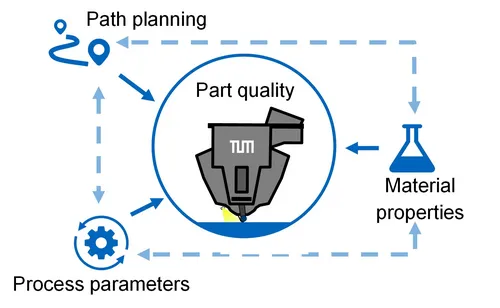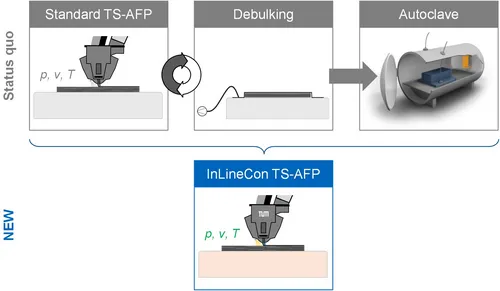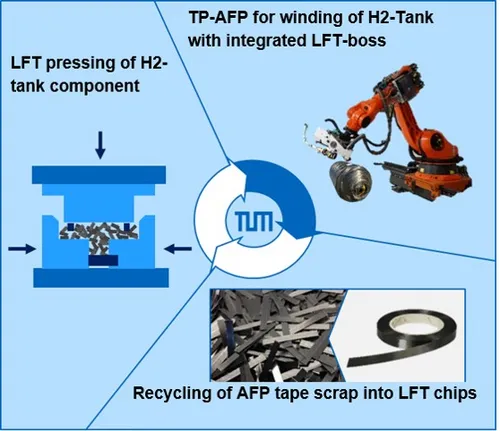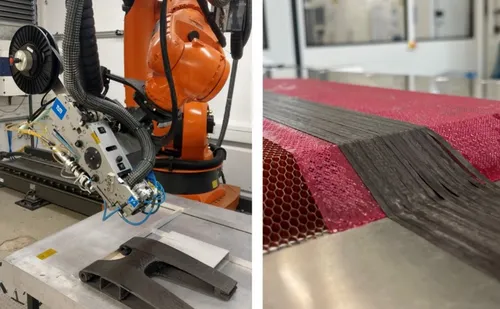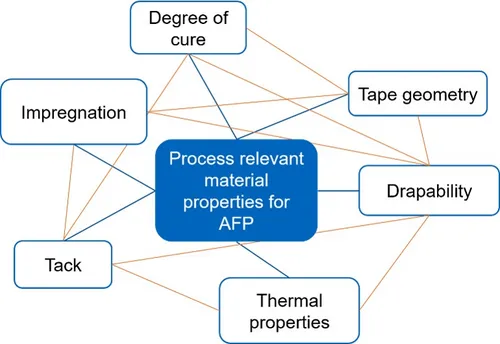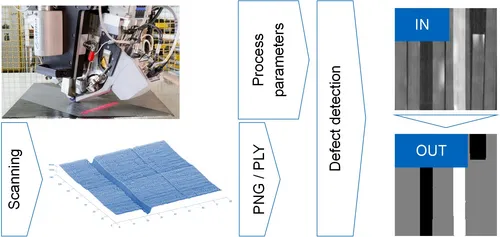Description of the topic
The interaction of various process parameters for thermoset and thermoplastic AFP is investigated experimentally and with simulation support in order to optimize component quality and production times.
Goals of the topic
• Process automation through OPM and AI
• Hybridization of manufacturing processes
• Sustainability through the use of new materials and recycling
Topic head
Fabian Diemar, M.Sc.;
Topic poster
Description (pdf)
Introduction
Automated Fiber Placement (AFP) is an automated manufacturing process for composite components. A robot-guided placement head places tapes of CFRP material on three-dimensional tool surfaces under defined pressure and heat.
The Chair of Carbon Composites operates two robot-based AFP systems for thermoset (TS) and thermoplastic (TP) material processing.
Thermoset AFP
During TS-AFP so-called "prepreg slit tapes" are placed on the mold. These are carbon fiber reinforced tapes cut to width and pre-impregnated with resin. After being laid-up, they are packed in a vacuum bag and cured at high temperature in an autoclave.
A Coriolis machine with the following specifications is available for research and manufacturing activities:
• 8 x 1/8‘‘ TS Prepreg-Tapes (Slit-Tapes, Towpreg). The material is automatically fed from the cooled material storage to the lay-up head.
• Heat application during lay-up with an IR lamp
• Lay-up speed up to 500 mm/s
The system consists of a 6-axis industrial robot, which can be moved on a linear axis. The tool is mounted on an additional rotational axis. This enables the production of large, complex 3D components. The production of rotationally symmetrical components (AFP and winding) is also possible.
Thermoplastic AFP
During in-situ consolidation in thermoplastic AFP processes (AFPisc), the fiber-reinforced tapes are consolidated with the substrate under pressure and temperature. Through the controlled application of heat by means of a laser, subsequent autoclaving is optional and possible depending on the material properties.
The Chair of Carbon Composites owns to TP-AFP machine of the company AFPT.
• 0.5 – 2‘‘ tape width
• In-situ consolidation through 4kW Laser
• Lay-up speed up to 200 mm/s during AFP, up to 1000 mm/s during winding
Challenges during the process
- Path planning: Appearance of lay-up defects due to non-geodetic curves
- Process development: Interaction of process parameters, material properties and lay-up quality
- Process control: Heat entry and control during AFPisc using laser and thermal camera, lay-up monitoring with laser profilometry
Research highlights
In the topic field the interaction of various process parameters for both AFP technologies is being investigated experimentally and with simulation support in order to optimize component quality and production times. The following research highlights are investigated:
Hybrid structures
The hybridization of manufacturing technologies and structures (AFP, 3D Printing, Sandwich structures) offers freedom in the part design. At LCC, the bonding of core and top layers by an optimized material selection and the interaction with the process are investigated.




